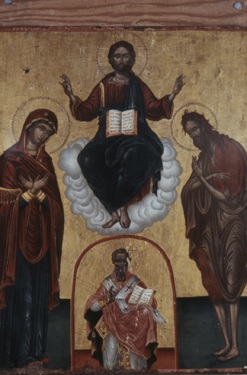
Unknown
Greek
Christ, the Virgin Mary, Saint John the Baptist, and Saint Nicholas, 1600-1700, ca.
egg tempera on wood panel
19 1/8 x 15 in.
SBMA, Anonymous Gift
1961.5.1
COMMENTS
Description
The central figure in this icon is Christ the Pantocrator (Ruler of the Universe) seated on the clouds of heaven. He extends both hands in benediction over the Virgin Mary on His right and St. John the Baptist on His left. Directly below Christ and under an arch is St. Nicholas, one of the most popular saints in the Christian world.
Origin and Iconography
The term Deesis comes from the Greek word meaning “prayer” and stems from references to the Last Judgment and church hymns of the 5th and 6th centuries. The Virgin Mary, wearing a red maphorion, symbolizes the Church and the New Testament. St. John the Baptist, wearing an olive robe over a red camelhair garment, symbolizes the Synagogue and the Old Testament. They offer prayers on behalf of mankind before Christ, the Eternal Judge.
On the gold leaf background the halos are outlined by circular punch-marks, a typical Western feature. Christ’s halo encloses an outlined cross within which are the Greek letters OWN, meaning “The Being” or “The Eternal.” (Exodus 3:14) This is the divine name of Jehovah revealed to Moses and belonging to the Divine Nature of Christ. It became a standard feature in icons of Christ beginning about the 13th century. Also traditional are the abbreviated inscriptions NCXC flanking the halo. These stand for Jesus Christ. The Gospel Book on Christ’s lap is open to a passage from the Gospel according to St. John: “I am the bread of Life. Whoever comes to me shall never be hungry and whoever believes in me shall never be thirsty.” (6:35 N.E.B.) Above the virgin’s halo is her usual title, Mother of God, in abbreviated form (MPΘV). Her maphorion is decorated with three stars, symbolizing her perpetual virginity, before, during, and after the birth of Christ.
St. Nicholas was probably the family or name saint of the individual who commissioned the icon. Many legends grew up around this 4th-century bishop of Myra in what is today southern Turkey. He eventually became the patron saint of the weak, the poor, the captive, the prisoner, the slave, young marriageable girls, and schoolboys. In Russia he was particularly popular, becoming the chief patron saint of the country. The Byzantine emperor Justinian dedicated a church to St. Nicholas in Constantinople c. 560. Two dozen additional churches or chapels were dedicated to him there in subsequent years. Numerous miracles were attributed to him, causing him to be given the title, “The Wonder Worker.” In the Santa Barbara icon, St. Nicholas is dressed as a bishop in an omophorion decorated with black crosses. At his side is a lozenge-shaped epigonation. He gives a blessing with his right hand, and in his covered left hand holds a Gospel Book open to a passage in St. John’s Gospel: “I am the Lord. I am the door; anyone who comes into the fold through me shall be safe. He shall go in (and out and shall find pasturage).” (10:9, N.E.B.). His white beard and high forehead are distinctive traits of this popular saint.
Style
In Venice, the influence of the Greek colony, which included icon painter from Crete, reached its height during the period 1570-1640. Icon painters in this colony incorporated a number of stylistic features that are clearly Western in origin. The rather hard linearism and stylization of lights and darks in the drapery folds are features of the Creto-Venetian style, as is the brownish-ochre (proplasmis) layer of paint which appears in the shaded parts of the figures. In addition, the color scheme used with the Virgin, wine-red maphorion and medium-blue tunic, is associated with this school (see Thalia Gouma Peterson, “Crete, Venice, the ‘Madonneri’ and a Creto-Venetian icon in the Allen Art Museum,” Allen Memorial Art Museum Bulletin, vol. XXXV, No. 2, Winter 1968, pp. 58-86).
- Robert Henning, Jr., "Russian Icons in Santa Barbara," Santa Barbara Museum of Art, 1982
Bibliography
Chatzidakis, M., Icones de Saint Georges des Grecs et de la collection de l’institut Hellenique de Veinse. Venice, 1962.
Haussig, J.W., A History of Byzantine Civilization, pp. 229, 361-62.
Rothemund, Bohs, Handbuch de Ikonenkunst, Munich, 1966.
Voyce, A., The Art and Architecture of Medieval Russia, Oklahoma, 1967, pp. 216-19.
SBMA CURATORIAL LABELS
This relatively small panel was probably used at home. Nicholas, fourth-century bishop of the city of Myra (now in Turkey), may have been patron saint of the person who commissioned it. Nicholas is depicted at the bottom, closer to the viewer, while Christ above is shown blessing from heaven. Mary and Saint John turn towards Him, their hands crossed in a gesture of prayer. (People would have prayed in front of this image a similar manner.)
The book in Christ's lap contains the words: "I am the bread of life; he who comes to Me will not hunger, and he who believes in Me will never thirst" (John 6:35). Saint Nicholas holds the text (read out in church on his feast day, December 6): "The Lord said: 'I am the door; by me if any man enter in, he shall be saved and shall go in' (John 10:9)".
- Religious Images of the Christian East, 2013
